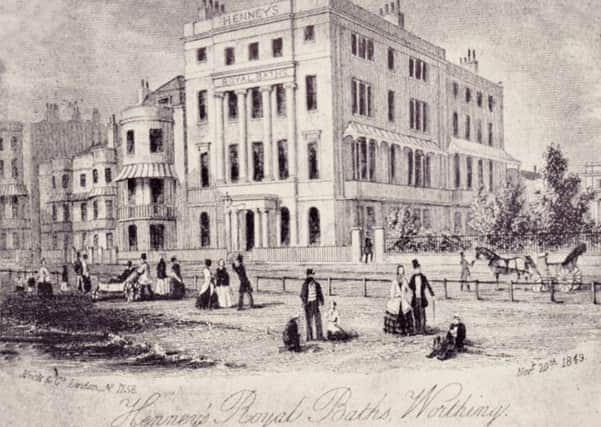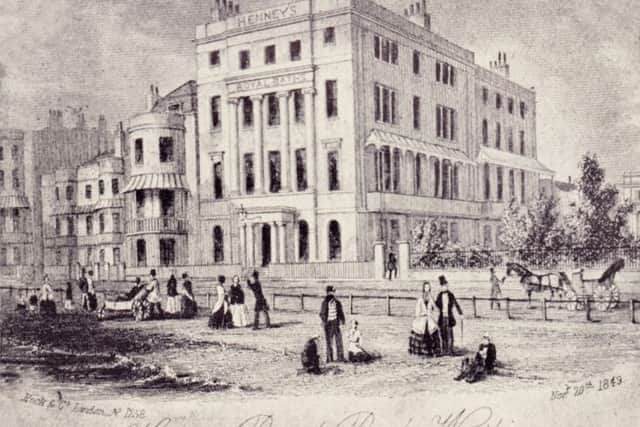Thomas Trotter and the Royal Baths


Perhaps this is partly due to the nature of two of the names, since developers might not be keen to build a Trotter House or an Ogle Mansions.
But these three exceptional men should not be forgotten, since without their presence in the town, the development of early Worthing – and to some extent the shape of the town today – would have been very different
Advertisement
Hide AdAdvertisement
Hide AdThe life and work of Edward Ogle is fully documented in my book ‘Jane Austen’s Worthing’. Ogle knew Jane Austen, and he was the inspiration for one of the characters in her final, unfinished novel ‘Sanditon’, which drew much of its inspiration from her stay in Worthing in 1805.


The life of Thomas Trotter is recorded in some detail in Mary Theresa Odell’s ‘More About the Old Theatre, Worthing’, published in 1945; and much of the information in the present article is drawn from Odell’s book.
Thomas Trotter
Trotter was born in 1779, and by 1794, when he was 15, he was already an actor, based at Hythe in Kent.
It appears that from an early age Trotter developed an interest in the managerial and entrepreneurial side of the theatre, although he never lost his love of appearing on the stage.
Advertisement
Hide AdAdvertisement
Hide AdIn the summer of 1802 – and seemingly in subsequent summers – Trotter held theatrical performances in a barn at the top of Worthing High Street. There was a three-month season, from August to October.
These productions were well received, and on June 29 the following year, 34 residents signed a petition advocating the construction of a permanent theatre.
The name at the head of the list, inevitably, was that of Edward Ogle, and it was Ogle who financed the building of the theatre on land he owned on the north side of Ann Street.
In the meantime, Trotter had built theatres at Milton – now Sittingbourne – in 1803, and Hythe, in 1804.
Advertisement
Hide AdAdvertisement
Hide AdThe Worthing theatre (Looking Back, October 24, 2013) opened in 1807.
The first season was a great success, and early the following year Ogle sold the theatre and the land adjoining it to Trotter for £2,260.
Trotter also ran theatres – often simultaneously – not only, as we have seen, in Hythe and Milton, but also in Shoreham, Littlehampton, Arundel, Gravesend, Maidstone and Southend.
From 1814–19, he ran the Brighton theatre in tandem with the Worthing theatre, but this was not a financial success, and when he gave up on Brighton he told the audience that he had had “plenty of employment in their service, but very little pay for it”.
Advertisement
Hide AdAdvertisement
Hide AdA journal called the Theatrical Inquisitor claimed that he had failed because he “entirely lacked industry, talent and spirit” – a spiteful and ill-informed thing to say of a man of such boundless energy and enthusiasm.
Worthing, however, was the centre of Trotter’s empire, and here his activities extended beyond the theatrical.
He was, for example, the driving force behind the construction in 1819–21 of the Esplanade, the raised walkway between Splash Point and West Buildings; and in 1818–23 he arranged for a new and splendid baths, with associated accommodation, to be built on the seafront.
The Royal Baths
Trotter’s new Royal Baths were a grander rival to Worthing’s existing bath-house, Wicks’s Original Royal Baths (Looking Back, August 28 – the term “Royal” was very freely used in those days!).
Advertisement
Hide AdAdvertisement
Hide AdFor most of the 1820s, Wicks’s Baths, which had been patronised by Jane Austen’s sister Cassandra in 1805, were still located in a humble single-storey building at the sea-end of Bath Place.
Trotter’s Royal Baths were built a little to the west, at the north-east corner of a lost street called Paragon Street, almost opposite the site that was in due course to be occupied by Worthing’s various bandstands.
The architect was John Rebecca, who was also responsible for Beach House, the Chapel of Ease (later St Paul’s) and Castle Goring.
The main entrance to the Royal Baths was on Trotter’s new Esplanade, with a second entrance just round the corner, facing east.
Advertisement
Hide AdAdvertisement
Hide AdThe seafront entrance provided the access to the baths and the waiting, reading and drawing rooms associated with it, while the side entrance provided access to the accommodation.
The baths were supplied with sea-water by pipes that went out a long distance into the sea, in order to avoid contamination.
At each returning tide, a self-acting hydraulic engine conveyed the water to a reservoir at the baths. A sea-water bath – either cold, or quickly heated by steam – was therefore available at any time.
Different types of bath were on offer, including “Indian Medicated”, “Vapour”, “Shampoo”, “Shower and Douche”, and so on.
Advertisement
Hide AdAdvertisement
Hide AdThe baths for gentlemen were on the ground floor, and those for ladies on the first floor.
Later Uses
Attached to the north of the main building were two houses, originally known as Marlborough Houses (in the plural).
I have not been able to establish when the Royal Baths closed, but it may have been soon after the much larger and more modern West Worthing Baths opened behind Heene Terrace in 1865.
Another bath-house, the Steyne Baths, opened in 1886 in the single-storey building that now houses the Wandering Goose, just to the west of the Chatsworth Hotel.
Advertisement
Hide AdAdvertisement
Hide AdBy 1870, the part of the old Royal Baths building that faced east had been renamed 1 Marlborough Terrace, and the two Marlborough Houses were 2 and 3 Marlborough Terrace.
These houses are most clearly seen on the colour-tinted postcard, on which 2 Marlborough Terrace is brown, and 3 Marlborough Terrace, to its north, is cream-coloured.
During the 1870s and the first half of the 1880s, 2 Marlborough Terrace was occupied, intriguingly, by a French nobleman living in exile called the Chevalier de la Peletière.
The Chevalier appears for the last time in the 1885 directory, so he must have died about then, but his widow continued to occupy the house until around 1892.
Advertisement
Hide AdAdvertisement
Hide AdMeanwhile, the two component parts of the old Royal Baths had become two separate boarding-houses. These were known in 1900 as Marlborough House – this was the part of the building with its front door on the seafront – and Argyle House, previously 1 Marlborough Terrace.
By 1906, the two boarding-houses had been combined to form the Marlborough House Boarding Establishment, run by the Misses Powis – and the colour-tinted postcard dates from a few years after that.
Later, the establishment was renamed the Marlborough Hotel, and this name can be seen on the east-facing side of the building on the monochrome postcard, which dates from around 1930.
The date usually given for the demolition of the building is 1940 – but, interestingly, a caption in Odell’s book says that it was demolished “just prior to the World War”.
Advertisement
Hide AdAdvertisement
Hide AdSince the book was published only a few years afterwards – in 1945 – this dating has some credibility; so perhaps the building was, in fact, demolished in 1939.
After Trotter’s Death
Thomas Trotter died in Worthing on September 8, 1851.
He had expressed a wish to be interred in the town, but he left the final decision to his wife, Margaret, and she decided that he should be buried at Gravesend, which was probably the town of his birth.
As can be seen from the photograph of his tomb, he was sufficiently notable a figure to be given quite a grand memorial.
Margaret died just over four years later, on January 5, 1856, and was buried in the same grave.
Advertisement
Hide AdAdvertisement
Hide AdThe dates on the gravestone are the dates of interment, eight days after death in Thomas’s case, seven in the case of Margaret.
This fact must serve as a caution for those that, understandably, take dates on gravestones as the date of death, since putting the date of interment on a grave must have been a common practice – if distinctly unhelpful as far as posterity is concerned.
The middle of the 19th century was a time when Worthing was in the doldrums, and Trotter’s extensive property portfolio in the town went for absurdly low prices when it was sold, most of it at an auction held in 1852.
Cottages at 9 and 14 Warwick Place went for £155 and £190 respectively; a house at 6 Egremont Place for £235; 4–5 Market Street for £145; 6 Market Street for £150; 7 Market Street for £135; and two houses in Ann Street for £235 and £180 respectively.
Advertisement
Hide AdAdvertisement
Hide AdThe Royal Baths and Marlborough House – which had cost £5,237 to build three decades earlier – fetched either £900 or £1,900. (Odell’s book gives different figures on different pages.)
After Margaret Trotter’s death in 1856, the Trotters’ “cottage ornée” in Ann Street, which had cost £2,739 to build, sold for £240; and the historic Ann Street theatre, which had cost £6,992, sold for just £160, to serve for the next century or so as a bacon and cheese store for Worthing’s leading grocers, Potter, Bailey & Co.
• Antony Edmonds’s books ‘Worthing: The Postcard Collection’ and ‘Jane Austen’s Worthing: The Real Sanditon’ are for a limited time available at Worthing Library at the special price of £2-50 off RRP.